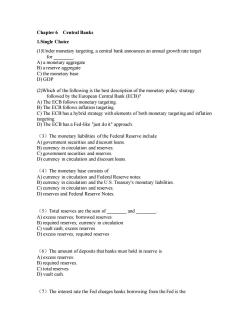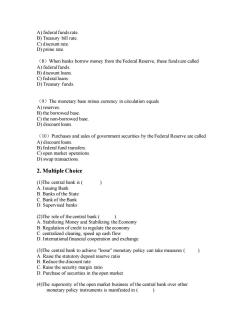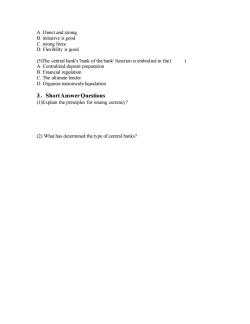同济大学:《货币金融学》课程教学资源(试卷习题)Chapter 6 Central Banks

Chapter 6 Central Banks 1.Single Choice (1)Under monetary targeting,a central bank announces an annual growth rate target for A)a monetary aggregate B)a reserve aggregate C)the monetary base D)GDP (2)Which of the following is the best description of the monetary policy strategy followed by the European Central Bank(ECB)? A)The ECB follows monetary targeting. B)The ECB follows inflation targeting. C)The ECB has a hybrid strategy with elements of both monetary targeting and inflation targeting. D)The ECB has a Fed-like "just do it"approach. (3)The monetary liabilities of the Federal Reserve include A)government securities and discount loans. B)currency in circulation and reserves C)government securities and reserves. D)currency in circulation and discount loans. (4)The monetary base consists of A)currency in circulation and Federal Reserve notes. B)currency in circulation and the U.S.Treasury's monetary liabilities. C)currency in circulation and reserves. D)reserves and Federal Reserve Notes. (5)Total reserves are the sum of and A)excess reserves;borrowed reserves B)required reserves;currency in circulation C)vault cash;excess reserves D)excess reserves;required reserves (6)The amount of deposits that banks must hold in reserve is A)excess reserves. B)required reserves. C)total reserves. D)vault cash. (7)The interest rate the Fed charges banks borrowing from the Fed is the
Chapter 6 Central Banks 1.Single Choice (1)Under monetary targeting, a central bank announces an annual growth rate target for ________. A) a monetary aggregate B) a reserve aggregate C) the monetary base D) GDP (2)Which of the following is the best description of the monetary policy strategy followed by the European Central Bank (ECB)? A) The ECB follows monetary targeting. B) The ECB follows inflation targeting. C) The ECB has a hybrid strategy with elements of both monetary targeting and inflation targeting. D) The ECB has a Fed-like "just do it" approach. (3)The monetary liabilities of the Federal Reserve include A) government securities and discount loans. B) currency in circulation and reserves. C) government securities and reserves. D) currency in circulation and discount loans. (4)The monetary base consists of A) currency in circulation and Federal Reserve notes. B) currency in circulation and the U.S. Treasury's monetary liabilities. C) currency in circulation and reserves. D) reserves and Federal Reserve Notes. (5)Total reserves are the sum of ________ and ________. A) excess reserves; borrowed reserves B) required reserves; currency in circulation C) vault cash; excess reserves D) excess reserves; required reserves (6)The amount of deposits that banks must hold in reserve is A) excess reserves. B) required reserves. C) total reserves. D) vault cash. (7)The interest rate the Fed charges banks borrowing from the Fed is the

A)federal funds rate B)Treasury bill rate. C)discount rate. D)prime rate. (8)When banks borrow money from the Federal Reserve,these funds are called A)federal funds. B)discount loans C)federal loans. D)Treasury funds. (9)The monetary base minus currency in circulation equals A)reserves. B)the borrowed base. C)the non-borrowed base. D)discount loans. (10)Purchases and sales of government securities by the Federal Reserve are called A)discount loans. B)federal fund transfers. C)open market operations. D)swap transactions. 2.Multiple Choice (1)The central bank is A.Issuing Bank B.Banks of the State C.Bank of the Bank D.Supervised banks (2)The role of the central bank( A.Stabilizing Money and Stabilizing the Economy B.Regulation of credit to regulate the economy C.centralized clearing,speed up cash flow D.International financial cooperation and exchange (3)The central bank to achieve "loose"monetary policy can take measures A.Raise the statutory deposit reserve ratio B.Reduce the discount rate C.Raise the security margin ratio D.Purchase of securities in the open market (4)The superiority of the open market business of the central bank over other monetary policy instruments is manifested in (
A) federal funds rate. B) Treasury bill rate. C) discount rate. D) prime rate. (8)When banks borrow money from the Federal Reserve, these funds are called A) federal funds. B) discount loans. C) federal loans. D) Treasury funds. (9)The monetary base minus currency in circulation equals A) reserves. B) the borrowed base. C) the non-borrowed base. D) discount loans. (10)Purchases and sales of government securities by the Federal Reserve are called A) discount loans. B) federal fund transfers. C) open market operations. D) swap transactions. 2. Multiple Choice (1)The central bank is ( ) A. Issuing Bank B. Banks of the State C. Bank of the Bank D. Supervised banks (2)The role of the central bank ( ) A. Stabilizing Money and Stabilizing the Economy B. Regulation of credit to regulate the economy C. centralized clearing, speed up cash flow D. International financial cooperation and exchange (3)The central bank to achieve "loose" monetary policy can take measures ( ) A. Raise the statutory deposit reserve ratio B. Reduce the discount rate C. Raise the security margin ratio D. Purchase of securities in the open market (4)The superiority of the open market business of the central bank over other monetary policy instruments is manifested in ( )

A.Direct and strong B.initiative is good C.strong force D.Flexibility is good (5)The central bank's'bank of the bank'function is embodied in the() A.Centralized deposit preparation B.Financial regulation C.The ultimate lender D.Organize nationwide liquidation 3,ShortAnswer Questions (1)Explain the principles for issuing currency? (2)What has determined the type of central banks?
A. Direct and strong B. initiative is good C. strong force D. Flexibility is good (5)The central bank's 'bank of the bank' function is embodied in the ( ) A. Centralized deposit preparation B. Financial regulation C. The ultimate lender D. Organize nationwide liquidation 3、Short Answer Questions (1)Explain the principles for issuing currency? (2) What has determined the type of central banks?
按次数下载不扣除下载券;
注册用户24小时内重复下载只扣除一次;
顺序:VIP每日次数-->可用次数-->下载券;
- 同济大学:《货币金融学》课程教学资源(试卷习题)Chapter 5 Commercial Banks.docx
- 同济大学:《货币金融学》课程教学资源(试卷习题)Chapter 4 The Economics of Financial Intermediary.docx
- 同济大学:《货币金融学》课程教学资源(试卷习题)Chapter 3 Interest and Interest Rate.docx
- 同济大学:《货币金融学》课程教学资源(试卷习题)Chapter 2 Credit and Financial Instruments.docx
- 同济大学:《货币金融学》课程教学资源(试卷习题)Chapter 1 Money and Monetary System.docx
- 同济大学:《货币金融学》课程教学资源(大纲教案)教学大纲 The Economics of Money and Banking.pdf
- 吉林大学:《财政学》课程教学资源(试卷习题)远程教育考试样卷(无答案).doc
- 吉林大学:《经济法》课程电子教案(PPT教学课件,共十三章,授课对象:远程教育,授课教师:孙凤英).ppt
- 《财务管理》课程教学资源(专项报告)南宁市宾阳县生猪现代农业产业园实施方案(简版).pdf
- 《财务管理》课程教学资源(专项报告)存栏1120头商品猪养殖小区可行性研究报告(简版).pdf
- 《财务管理》课程教学资源(专项报告)存栏2000头祖代原种猪场可行性研究报告(简版).pdf
- 《财务管理》课程教学资源(专项报告)存栏3000头曾祖代原种猪场环保生态养殖综合开发项目可研报告(简版).pdf
- 《财务管理》课程教学资源(专项报告)存栏5000头基础母猪现代化生猪养殖场可行性研究报告(简版).pdf
- 《财务管理》课程教学资源(专项报告)山西灵空山国家级自然保护区2016年林业国家级自然保护区补助资金建设项目可行性研究报告(简版).pdf
- 《财务管理》课程教学资源(专项报告)森林康养度假建设项目可行性研究报告(简版).pdf
- 山西农业大学:《财务管理》课程教学资源(试卷习题)财务管理期末考试模拟题三及答案.pdf
- 山西农业大学:《财务管理》课程教学资源(试卷习题)财务管理期末考试模拟题二及答案.pdf
- 山西农业大学:《财务管理》课程教学资源(试卷习题)财务管理期末考试模拟题一及答案.pdf
- 山西农业大学:《财务管理》课程教学资源(试卷习题)第八章 利润分配管理(含答案).pdf
- 山西农业大学:《财务管理》课程教学资源(试卷习题)第七章 营运资金管理(含答案).pdf
- 同济大学:《货币金融学》课程教学资源(试卷习题)Chapter 7 Financial Markets.docx
- 同济大学:《货币金融学》课程教学资源(试卷习题)Chapter 8 Money Supply and Money Demand.docx
- 同济大学:《货币金融学》课程教学资源(试卷习题)Chapter 9 Money and Inflation.docx
- 同济大学:《货币金融学》课程教学资源(试卷习题)Answers for Test Sample(参考答案)Chapter 1-10.docx
- 同济大学:《货币金融学》课程电子教案(课件讲稿)Chapter 1 Introduction(负责人:郭英).pdf
- 同济大学:《货币金融学》课程电子教案(课件讲稿)Chapter 2 Money and Monetary System.pdf
- 同济大学:《货币金融学》课程电子教案(课件讲稿)Chapter 3 Credit and Financial Instrument.pdf
- 同济大学:《货币金融学》课程电子教案(课件讲稿)Chapter 4 Interest and Interest Rate.pdf
- 同济大学:《货币金融学》课程电子教案(课件讲稿)Chapter 5 Financial Institutions.pdf
- 同济大学:《货币金融学》课程电子教案(课件讲稿)Chapter 6 Commercial Banks.pdf
- 同济大学:《货币金融学》课程电子教案(课件讲稿)Chapter 7 Central Banks.pdf
- 同济大学:《货币金融学》课程电子教案(课件讲稿)Chapter 8 Financial Markets.pdf
- 同济大学:《货币金融学》课程电子教案(课件讲稿)Chapter 10 Monetary Policy.pdf
- 同济大学:《货币金融学》课程电子教案(课件讲稿)Chapter 9 Money Demand and Money Supply.pdf
- 同济大学:《货币金融学》课程电子教案(课件讲稿)Chapter 11 Inflation and Deflation.pdf
- 吉林大学:《会计学》课程电子教案(PPT课件)第一章 绪论(负责人:孙烨).ppt
- 吉林大学:《会计学》课程电子教案(PPT课件)第二章 帐户与复式记帐.ppt
- 吉林大学:《会计学》课程电子教案(PPT课件)第三章 分录与记帐.ppt
- 吉林大学:《会计学》课程电子教案(PPT课件)第四章 试算与调整.ppt
- 吉林大学:《会计学》课程电子教案(PPT课件)第十章 无形资产与其他资产.ppt
